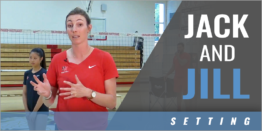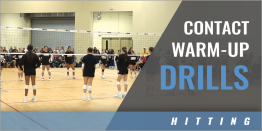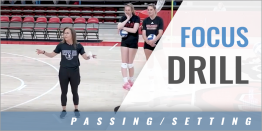|
By: Tom Black - Head Women's Volleyball Coach at the University of Georgia. Previously the Head Women's Volleyball Coach at Loyola Marymount University. Originally Published in: Coaching Volleyball Magazine
SERVING IS A CLOSED-LOOP SKILL. All of the other skills in volleyball are open, which means there are a number of random variables occurring simultaneously that have an impact on the final outcome. As a hitter, you cannot control the set; as a passer, you cannot control the serve; and as a blocker or defender, you cannot control what the opposing hitter does. When serving the volleyball, the player controls all the elements of the skill, just like playing a guitar or swinging a golf club. When a player has control of the skill of serving, a bigger and stronger opponent can easily be neutralized. As a coach, I have never been in a gym where the players served more balls in practice than they spiked. The question then becomes, "Is it okay to spike more balls in practice than we serve?" I want to pose that question for a couple of reasons. It is my contention — and it is completely unscientific — that serving is the least trained skill in the world, especially in the women's game. As coaches, if we look at a team pass and hit, and we observe the setter play the game, we can easily see what that coach is trying to communicate to the players. We can determine that everyone on the team is trying to pass a certain way, hit a certain way, and definitely set a certain way. Whether we agree with it or not, we can generally see that is that team's "system." When it comes to serving — even on the international level — execution of the skill is a somewhat random. From one player to the next, it is not quite clear what is being taught, and it is not nearly as obvious as when you study a team's passing or hitting. As a result, I think ambiguity is the enemy of learning. If it is not clear exactly how we want our athletes to serve, then obviously they cannot learn as well and we can't teach as well. What do statistics tell us about serving? Interestingly enough, statistics speak volumes about a team and its serving abilities. In 2004, the U.S. Men's National Volleyball Team hired a gentleman named Dr. Gil Fellingham, a professor of statistics at BYU, to conduct a statistical survey to list the most productive outcomes in volleyball and the least productive ones. Obviously, U.S. Men's National Team Head Coach Doug Beal and his staff wanted to use the results in training for the Olympic Games. The statistics revealed that the worst thing you could do in volleyball in the men's game was to miss the serve. The second worst thing you could do was serve a ball that the opponent passed perfectly. The third worst thing you could do was to serve a ball that the opponent passed "okay" (a 2-point pass) and the fourth worst thing was an attacking error. Indeed, it was pretty surprising to the coaches that the three least productive outcomes in volleyball all had to do with serving, while an attacking error was fourth on the list. It was also very surprising that passing "just okay" was that damaging to our side of the net. That was a wake-up call regarding just how important serving is. A few years later, Jason Watson, when he was head coach at BYU, worked with Fellingham to see if any of these same principles applied to the women's game. Again, they conducted a study to determine the most productive and least productive aspects in the women's game. The first, third and fourth most productive events in women's volleyball all have to do with passing. The best thing we can do is pass a 3-point pass (one that is a little bit off). The third best thing we can do in volleyball is a 4-point pass (and there is nothing that is completely perfect). The fourth best thing we can do in volleyball is a 2-point pass (a 2 option). A good pass, a perfect pass and an okay pass are more productive than a perfect dig. Surprisingly, the left-side attack was all the way down to No. 8 on the list. These results were certainly shocking to a lot of people. The left-side attack — the most common way to score in volleyball — is only the eighth most productive event, and the first, third and fourth all have to do with passing.To be sure, volleyball is a unique action/reaction game. Serving affects passing and effective passing is the ability to control the serve. What do we glean from this information? Serving and passing are inextricably linked. One thing we need to understand is if we can control both phases of this game — if we can win the serving and passing battle every single match — we can win 75 percent of our games just by controlling that battle. This idea might be the most important element of what we train as coaches. From what we saw from the Fellingham study, it is also really important that we pass well. However, it is also crucial that not only do we prevent our opponent from passing well, but we also try to prevent them from passing even "okay." Statistically speaking, even a 2-point pass is a pretty productive thing for the opponent to do. As a result, that puts a ton of pressure on how well we can serve. Obviously, our ability to serve effectively limits the opponent's ability to pass well. This has to be a very important aspect in the training gym. The other crucial item discovered about serving from these studies is twofold: we need to serve tough and we need to serve in every single time. I don't know if any other skill in volleyball poses the same challenge. A player can pass the ball 20 feet off the net, which is maybe a 1-point pass, and if we have a really big attacker on the left side, we can still score. A player can get a bad set and still tip the ball and score. A setter might not deliver a very good set, but the hitter can do something with it and still score. We cannot do that when it comes to serving. We obviously can't miss our serve because it is going to give the opponent a point. We also cannot serve an easy ball, either, because that is going to allow them a first-ball kill, which is really damaging to our game, as well. We need to serve tough and in, and that puts a lot of pressure on the quality of training that skill in the gym. Which serve is best? Armed with all of this statistical information, the question becomes, "What serve should coaches train?" Indeed, we should train the serve that scores! There are three high-level serves an individual player can choose from: a standing float, a jump float and a jump serve. Obviously, the serve that your individual server can score with is the serve she should execute! Returning to the Fellingham study, we note that the first two serves that pop up on the most productive skills list are the 3-point float serve and the 3-point jump serve. As you go down the list in the study, you always see that the float serve is ahead of the jump serve. At UC San Diego, we conducted an interesting study whereby we took the jump serve, the jump float and the standing float and measured how many times each was done, how many aces there were, how many errors there were, and the point scoring percentage (If I served 10 balls and I scored five times, my point scoring percentage was 50 percent). We conducted this study every year for the five years I was at UCSD and we determined that the jump float was the best serve. The standing float was a little bit behind it and the jump serve was much worse. For example, at UCSD in 2007, when we executed the jump float, we point scored at 50 percent, which is very good, and our error percentage was 16 percent, which we found to be a little high. We wanted it to be around 12 percent. With the standing float serve, we were a little bit worse. We point scored 49 percent, so we were just one percentage point lower, but our error percentage was a lot better. When compared to the opponent, our jump float was the best serve. The jump serve, whether by UCSD or the opponent, was way below the other serves. We found this to be true every year, which followed in line with Fellingham's study. How do we train the serve? As coaches, do we want to train speed with our servers? Do we want to train them to serve hard and fast? Do we want to train them to be accurate so they can serve to the deep corners and serve short? Or, do we want to train both speed and accuracy? There is a motor learning principle called the Law of Specificity, which states that learning is most effective when the practice environment and skill movements most closely resemble those in competition. In other words, as coaches, we need to specifically train exactly what we are trying to do in the game. If we are trying to train our players to serve tough and in, then we need to practice serving tough and in—not just tough and not just in. There are three elements of the serve that need to be broken down for each server: the rhythm, the toss and the contact. Those three elements simply have to be executed the same each time. No matter what skill we are teaching, whether it be serving or hitting, the best players' skills are repeatable. As a result, coaches should teach mental routines, along with teaching specific keys for serving. It is great when everyone in the gym is clear on what the simple keys are for how to perform the jump float, the standing float and the jump serve. Establish those keys early so the coaches and players are on the same page. Undeniably, great players have great movement patterns. They move well when they pass and when they hit. They always look the same, and the movement patterns are simple. It is the same for great servers. Their bodies move in an efficient, simple, clear way. Another motor learning principle is that thoughts and environment are part of the motor pattern, which is why there is such a thing as home-court advantage. A mental routine is something we cannot see, but we can talk about. It might allow the server to give herself something she can rely on and allow herself to be the same, even though the environment and situations change every time. That is important because thoughts and emotions are absolutely a part of the motor program. Talk about specific routines with your athletes and make them a part of the serving reps. Training aids There are three items that can help train your servers on a consistent basis: a radar gun, a white board and a chart to measure varying serve types. The radar gun will help develop target speeds with the athletes. The white boards allow you to create and show serving maps to athletes so they can help determine which areas on the floor they are good at hitting and which areas they need to work on. You can use mats or targets on the other side of the net as a visual aid to help players serve to the proper area. At Loyola Marymount, we have a really simple chart that then measures the types and effectiveness of various serves. If a player does a standing float, a jump float or a jump serve, we measure the speed on the radar gun, measure the movement of the serve, and then measure the result (ace, effective pass by opponent, etc.). We then try to find some ranges so as to determine what this player's target speed should be, and how much ball movement is workable. Eventually, the players have served so many balls with such clear feedback that they know how hard to swing, what the contact feels like, and if they are where they want to be when it comes to the end result. What percentages should be reinforced? Once you determine which serve—or serves— work best for your cadre of players, then you can do some things to monitor them throughout the course of the year. The main two statistics that we use are point scoring percentage and error percentage. We use them as a gauge for both the team and individual players. Obviously, the big question then becomes, "What is the proper point scoring percentage and what is the right error percentage as a server?" In this case, you definitely have to know the opponents' abilities, as well as your own teams. You should conduct your own study to figure out what the point scoring percentage was when you won games and what the error percentage was when the opponent won. During my last couple of years at UCSD, we found that when our point scoring percentage was at 50 percent and our error percentage was 12-13 percent, we were winning almost every time. Our servers developed an ability to meet those percentages. Conclusion Keep track of the speed, movement and result of every serve possible, whether it be in practice or in competition. When you insist your players control their serves, as well as serve tough and in each time, you can direct the outcome of the match in your favor.
|







